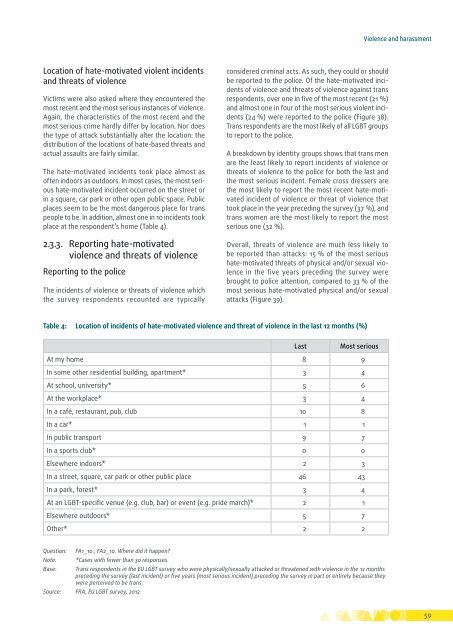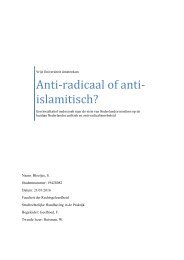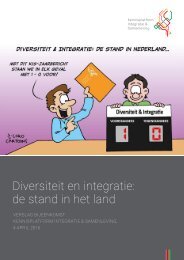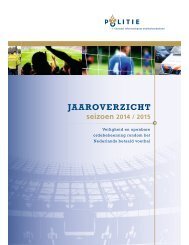fra-2014-being-trans-eu-comparative_en
fra-2014-being-trans-eu-comparative_en
fra-2014-being-trans-eu-comparative_en
You also want an ePaper? Increase the reach of your titles
YUMPU automatically turns print PDFs into web optimized ePapers that Google loves.
Viol<strong>en</strong>ce and harassm<strong>en</strong>tLocation of hate‐motivated viol<strong>en</strong>t incid<strong>en</strong>tsand threats of viol<strong>en</strong>ceVictims were also asked where they <strong>en</strong>countered themost rec<strong>en</strong>t and the most serious instances of viol<strong>en</strong>ce.Again, the characteristics of the most rec<strong>en</strong>t and themost serious crime hardly differ by location. Nor doesthe type of attack substantially alter the location: thedistribution of the locations of hate‐based threats andactual assaults are fairly similar.The hate‐motivated incid<strong>en</strong>ts took place almost asoft<strong>en</strong> indoors as outdoors. In most cases, the most serioushate‐motivated incid<strong>en</strong>t occurred on the street orin a square, car park or other op<strong>en</strong> public space. Publicplaces seem to be the most dangerous place for <strong>trans</strong>people to be. In addition, almost one in 10 incid<strong>en</strong>ts tookplace at the respond<strong>en</strong>t’s home (Table 4).2.3.3. Reporting hate‐motivatedviol<strong>en</strong>ce and threats of viol<strong>en</strong>ceReporting to the policeThe incid<strong>en</strong>ts of viol<strong>en</strong>ce or threats of viol<strong>en</strong>ce whichthe survey respond<strong>en</strong>ts recounted are typicallyconsidered criminal acts. As such, they could or shouldbe reported to the police. Of the hate‐motivated incid<strong>en</strong>tsof viol<strong>en</strong>ce and threats of viol<strong>en</strong>ce against <strong>trans</strong>respond<strong>en</strong>ts, over one in five of the most rec<strong>en</strong>t (21 %)and almost one in four of the most serious viol<strong>en</strong>t incid<strong>en</strong>ts(24 %) were reported to the police (Figure 38).Trans respond<strong>en</strong>ts are the most likely of all LGBT groupsto report to the police.A breakdown by id<strong>en</strong>tity groups shows that <strong>trans</strong> m<strong>en</strong>are the least likely to report incid<strong>en</strong>ts of viol<strong>en</strong>ce orthreats of viol<strong>en</strong>ce to the police for both the last andthe most serious incid<strong>en</strong>t. Female cross dressers arethe most likely to report the most rec<strong>en</strong>t hate‐motivatedincid<strong>en</strong>t of viol<strong>en</strong>ce or threat of viol<strong>en</strong>ce thattook place in the year preceding the survey (37 %), and<strong>trans</strong> wom<strong>en</strong> are the most likely to report the mostserious one (32 %).Overall, threats of viol<strong>en</strong>ce are much less likely tobe reported than attacks: 15 % of the most serioushate‐motivated threats of physical and/or sexual viol<strong>en</strong>cein the five years preceding the survey werebrought to police att<strong>en</strong>tion, compared to 33 % of themost serious hate‐motivated physical and/or sexualattacks (Figure 39).Table 4: Location of incid<strong>en</strong>ts of hate‐motivated viol<strong>en</strong>ce and threat of viol<strong>en</strong>ce in the last 12 months (%)LastMost seriousAt my home 8 9In some other resid<strong>en</strong>tial building, apartm<strong>en</strong>t* 3 4At school, university* 5 6At the workplace* 3 4In a café, restaurant, pub, club 10 8In a car* 1 1In public <strong>trans</strong>port 9 7In a sports club* 0 0Elsewhere indoors* 2 3In a street, square, car park or other public place 46 43In a park, forest* 3 4At an LGBT‐specific v<strong>en</strong>ue (e.g. club, bar) or ev<strong>en</strong>t (e.g. pride march)* 2 1Elsewhere outdoors* 5 7Other* 2 2Question:Note:Base:FA1_10.; FA2_10. Where did it happ<strong>en</strong>?*Cases with fewer than 30 responses.Trans respond<strong>en</strong>ts in the EU LGBT survey who were physically/sexually attacked or threat<strong>en</strong>ed with viol<strong>en</strong>ce in the 12 monthspreceding the survey (last incid<strong>en</strong>t) or five years (most serious incid<strong>en</strong>t) preceding the survey in part or <strong>en</strong>tirely because theywere perceived to be <strong>trans</strong>.Source: FRA, EU LGBT survey, 201259









